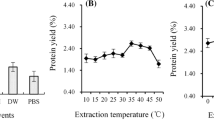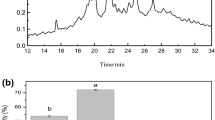Abstract
An alcalase-catalysed porcine placenta hydrolysate (PPH) with a 30% degree of hydrolysis was fractionated using two cycles of ultrafiltration (UF) with molecular weight cut-offs of 100 kDa and 30 kDa to search for novel bioactive peptides. The permeate of the 30 kDa UF (UF4) demonstrated superior radical scavenging activities (DPPH•/ABTS•+), ferric-reducing power, β-carotene bleaching inhibitory activity, nitric oxide scavenging activity, angiotensin-converting enzyme inhibition and anti-α-amylase/α-glucosidase activity with high antioxidant stability in an in vitro gastrointestinal tract model system. The UF4 fraction was rich in hydrophobic amino acids (e.g. valine, isoleucine, alanine, leucine and proline). The first five amino acid sequences identified in the UF4 fraction were LSSPATLNSR, ASISLPR, ILLEVNNR, ESLITLIEK and QPLLLDDR, with molecular weights ranging from 760 to 2682 Da. Based on the findings, the UF4 fraction isolated from crude PPH can be developed as a novel bioactive ingredient in functional foods with the potential for scale-up and economic feasibility.




Similar content being viewed by others
Data Availability
The data and the materials are all available in this article.
References
Ahn, C. B., Cho, Y. S., & Je, J. Y. (2015). Purification and anti-inflammatory action of tripeptide from salmon pectoral fin byproduct protein hydrolysate. Food Chemistry, 168, 151–156.
Bamdad, F., & Chen, L. (2013). Antioxidant capacities of fractionated barley hordein hydrolysates in relation to peptide structures. Molecular Nutrition & Food Research, 57, 493–503.
Chen, H. M., Muramoto, K., Yamauchi, F., & Nokihara, K. (1996). Antioxidant activity of designed peptides based on the antioxidative peptide isolated from digests of a soybean protein. Journal of Agricultural and Food Chemistry, 44, 2619–2623.
Cushman, D. W., & Cheung, H. S. (1971). Spectrophotometric assay and properties of the angiotensin-converting enzyme of rabbit lung. Biochemical Pharmacology, 20, 1637–1648.
Fadimu, G. J., Gill, H., Farahnaky, A., & Truong, T. (2021). Investigating the impact of ultrasound pretreatment on the physicochemical, structural, and antioxidant properties of lupin protein hydrolysates. Food and Bioprocess Technology, 14, 2004–2019.
Gómez-Ruiz, J. Á., López-Expósito, I., Pihlanto, A., Ramos, M., & Recio, I. (2008). Antioxidant activity of ovine casein hydrolysates: Identification of active peptides by HPLC-MS/MS. European Food Research and Technology, 227, 1061–1067.
Habebullah, S. F., Andersen, L. L., Otte, J., Nielsen, H. H., Jessen, F., & Jacobsen, C. (2016). Antioxidant activity of cod (Gadus morhua) protein hydrolysates: Fractionation and characterisation of peptide fractions. Food Chemistry, 204, 409–419.
Huang, G. Q., **ao, J. X., Hao, L. Q., & Yang, J. (2017). Microencapsulation of an angiotensin I-converting enzyme inhibitory peptide VLPVP by membrane emulsification. Food and Bioprocess Technology, 10, 2005–2012.
Huang, L., Ren, C., Li, H. J., & Wu, Y. C. (2021). Recent progress on processing technologies, chemical components, and bioactivities of Chinese red ginseng, American red ginseng, and Korean red ginseng. Food and Bioprocess Technology. https://doi.org/10.1007/s11947-021-02697-w
Ishak, N. H., & Sarbon, N. M. (2018). A review of protein hydrolysates and bioactive peptides deriving from wastes generated by fish processing. Food and Bioprocess Technology, 11, 2–16.
Jang, A., Jo, C., Kang, K. S., & Lee, M. (2008). Antimicrobial and human cancer cell cytotoxic effect of synthetic angiotensin-converting enzyme (ACE) inhibitory peptides. Food Chemistry, 107, 327–336.
Jiang, H., Tong, T., Sun, J., Xu, Y., Zhao, Z., & Liao, D. (2014). Purification and characterization of antioxidative peptides from round scad (Decapterus maruadsi) muscle protein hydrolysate. Food Chemistry, 154, 158–163.
Kim, S. K., Kim, Y. T., Byun, H. G., Nam, K. S., Joo, D. S., & Shahidi, F. (2001). Isolation and characterization of antioxidative peptides from gelatin hydrolysate of Alaska pollack skin. Journal of Agricultural and Food Chemistry, 49, 1984–1989.
Laosam, P., Panpipat, W., Yusakul, G., Cheong, L., & Chaijan, M. (2021). Porcine placenta hydrolysate as an alternate functional food ingredient: In vitro antioxidant and antibacterial assessments. PLoS One, 16, e0258445.
Lee, S. Y., & Hur, S. J. (2017). Angiotensin converting enzyme inhibitory and antioxidant activities of enzymatic hydrolysates of Korean native cattle (Hanwoo) myofibrillar protein. BioMed Research International, 2017.
Liu, J., **, Y., Lin, S., Jones, G. S., & Chen, F. (2015). Purification and identification of novel antioxidant peptides from egg white protein and their antioxidant activities. Food Chemistry, 175, 258–266.
Lu, X., Zhang, L., Sun, Q., Song, G., & Huang, J. (2019). Extraction, identification and structure-activity relationship of antioxidant peptides from sesame (Sesamum indicum L.) protein hydrolysate. Food Research International, 116, 707–716.
Ma, S., Zhang, M., Beta, T., Dong, T., Bao, X., & Li, Z. (2017). Purification and structural identification of glutelin peptides derived from oats. CyTA-Journal of Food, 15, 508–515.
Marco, G. J. (1968). A rapid method for evaluation of antioxidants. Journal of the American Oil Chemists’ Society, 45, 594–598.
Mohammad, A. W., Ng, C. Y., Lim, Y. P., & Ng, G. H. (2012). Ultrafiltration in food processing industry: Review on application, membrane fouling, and fouling control. Food and Bioprocess Technology, 5, 1143–1156.
Nagae, M., Nagata, M., Teramoto, M., Yamakawa, M., Matsuki, T., Ohnuki, K., & Shimizu, K. (2020). Effect of porcine placenta extract supplement on skin condition in healthy adult women: A randomised, double-blind placebo-controlled study. Nutrients, 12, 1671.
Pérez, R. A., Iglesias, M. T., Pueyo, E., González, M., & de Lorenzo, C. (2007). Amino acid composition and antioxidant capacity of Spanish honeys. Journal of Agricultural and Food Chemistry, 55, 360–365.
Qian, Z. J., Jung, W. K., Byun, H. G., & Kim, S. K. (2008). Protective effect of an antioxidative peptide purified from gastrointestinal digests of oyster, Crassostrea gigas against free radical induced DNA damage. Bioresource Technology, 99, 3365–3371.
Rajapakse, N., Mendis, E., Byun, H. G., & Kim, S. K. (2005). Purification and in vitro antioxidative effects of giant squid muscle peptides on free radical-mediated oxidative systems. The Journal of Nutritional Biochemistry, 16, 562–569.
Rajendran, S. R., Mason, B., & Doucette, A. A. (2021). Review of membrane separation models and technologies: Processing complex food-based biomolecular fractions. Food and Bioprocess Technology, 14, 415–428.
Rasaratnam, K., Nantasenamat, C., Phaonakrop, N., Roytrakul, S., & Tanyong, D. (2021). A novel peptide isolated from garlic shows anticancer effect against leukemic cell lines via interaction with Bcl-2 family proteins. Chemical Biology & Drug Design, 97, 1017–1028.
Roslan, J., Kamal, S. M. M., Yunos, K. F. M., & Abdullah, N. (2017). Assessment on multilayer ultrafiltration membrane for fractionation of tilapia by-product protein hydrolysate with angiotensin I-converting enzyme (ACE) inhibitory activity. Separation and Purification Technology, 173, 250–257.
Roslan, J., Kamal, S. M. M., Yunos, K. F. M., & Abdullah, N. (2018). Evaluation on performance of dead-end ultrafiltration membrane in fractionating tilapia by-product protein hydrolysate. Separation and Purification Technology, 195, 21–29.
Siow, H. L., Lim, T. S., & Gan, C. Y. (2017). Development of a workflow for screening and identification of α-amylase inhibitory peptides from food source using an integrated Bioinformatics-phage display approach: Case study–Cumin seed. Food Chemistry, 214, 67–76.
Sonklin, C., Laohakunjit, N., & Kerdchoechuen, O. (2018). Assessment of antioxidant properties of membrane ultrafiltration peptides from mungbean meal protein hydrolysates. PeerJ, 6, e5337.
Sripokar, P., Benjakul, S., & Klomklao, S. (2019). Antioxidant and functional properties of protein hydrolysates obtained from starry triggerfish muscle using trypsin from albacore tuna liver. Biocatalysis and Agricultural Biotechnology, 17, 447–454.
Sungpud, C., Panpipat, W., Yoon, A. S., & Chaijan, M. (2019). Tuning of virgin coconut oil and propylene glycol ratios for maximizing the polyphenol recovery and in vitro bioactivities of mangosteen (Garcinia mangostana L.) pericarp. Process Biochemistry, 87, 179–186.
Suttisuwan, R., Phunpruch, S., Saisavoey, T., Sangtanoo, P., Thongchul, N., & Karnchanatat, A. (2019). Isolation and characterisation of anti-inflammatory peptides derived from trypsin hydrolysis of microalgae protein (Synechococcus sp. VDW). Food Biotechnology, 33, 303–324.
Teng, D., Fang, Y., Song, X., & Gao, Y. (2011). Optimization of enzymatic hydrolysis parameters for antioxidant capacity of peptide from goat placenta. Food and Bioproducts Processing, 89, 202–208.
Thanapongtharm, W., Linard, C., Chinson, P., Kasemsuwan, S., Visser, M., Gaughan, A. E., & Gilbert, M. (2016). Spatial analysis and characteristics of pig farming in Thailand. BMC Veterinary Research, 12, 1–15.
Vandanjon, L., Grignon, M., Courois, E., Bourseau, P., & Jaouen, P. (2009). Fractionating white fish fillet hydrolysates by ultrafiltration and nanofiltration. Journal of Food Engineering, 95, 36–44.
Wu, H. C., Chen, H. M., & Shiau, C. Y. (2003). Free amino acids and peptides as related to antioxidant properties in protein hydrolysates of mackerel (Scomber austriasicus). Food Research International, 36, 949–957.
Yan, J., Zhao, J., Yang, R., & Zhao, W. (2019). Bioactive peptides with antidiabetic properties: A review. International Journal of Food Science & Technology, 54, 1909–1919.
Yoshikawa, C., Takano, F., Ishigaki, Y., Okada, M., & Kyo, S. (2013). Effect of porcine placental extract on collagen production in human skin fibroblasts in vitro. Gynecology & Obstetrics, 3, 1000186.
You, L., Zhao, M., Regenstein, J. M., & Ren, J. (2010). Changes in the antioxidant activity of loach (Misgurnus anguillicaudatus) protein hydrolysates during a simulated gastrointestinal digestion. Food Chemistry, 120, 810–816.
Yu, Z., Yin, Y., Zhao, W., Liu, J., & Chen, F. (2012). Anti-diabetic activity peptides from albumin against α-glucosidase and α-amylase. Food Chemistry, 135, 2078–2085.
Zamani, A., & Benjakul, S. (2016). Trypsin from unicorn leatherjacket (Aluterus monoceros) pyloric caeca: Purification and its use for preparation of fish protein hydrolysate with antioxidative activity. Journal of the Science of Food and Agriculture, 96, 962–969.
Zheng, P., Hao, G., Weng, W., & Ren, H. (2019). Antioxidant activities of hydrolysates from abalone viscera using subcritical water-assisted enzymatic hydrolysis. Food and Bioprocess Technology, 12, 910–918.
Zhuang, Y., Sun, L., & Li, B. (2012). Production of the angiotensin-I-converting enzyme (ACE)-inhibitory peptide from hydrolysates of jellyfish (Rhopilema esculentum) collagen. Food and Bioprocess Technology, 5, 1622–1629.
Zou, Y., Wang, W., Li, Q., Chen, Y., Zheng, D., Zou, Y., & Yang, L. (2016). Physicochemical, functional properties and antioxidant activities of porcine cerebral hydrolysate peptides produced by ultrasound processing. Process Biochemistry, 51, 431–443.
Funding
This work was supported by the National Research Council of Thailand (NRCT) under the Research and Researchers for Industries (RRI) program, Thailand, and Shaw Kaset Rungrueng Co. Ltd., Nakhon Si Thammarat, Thailand (Grant no. PHD62I0014). This research was financially supported by the new strategic research project (P2P) fiscal year 2022, Walailak University, Thailand. The foundations supported this study had no role in the study design, data collection or analysis. The authors alone are responsible for the content and writing of this paper.
Author information
Authors and Affiliations
Contributions
P.L. conducted the experiment, collected the data and prepared the manuscript. S.C. and N.P. collected the data. W.P., M.C., S.R., A.P., L.C. and G.Y. assisted with the experiments and writing. W.P. designed the experiment, supervised the research and revised the manuscript. All authors read and approved the final manuscript.
Corresponding author
Ethics declarations
Ethics Approval and Consent to Participate
This study did not include any human subjects and animal experiments. Consent to participate is not applicable.
Consent for Publication
Not applicable.
Conflict of Interest
The authors declare no competing interests.
Additional information
Publisher's Note
Springer Nature remains neutral with regard to jurisdictional claims in published maps and institutional affiliations.
Rights and permissions
About this article
Cite this article
Laosam, P., Panpipat, W., Chaijan, M. et al. Molecular Structures and In Vitro Bioactivities of Enzymatically Produced Porcine Placenta Peptides Fractionated by Ultrafiltration. Food Bioprocess Technol 15, 669–682 (2022). https://doi.org/10.1007/s11947-022-02781-9
Received:
Accepted:
Published:
Issue Date:
DOI: https://doi.org/10.1007/s11947-022-02781-9




